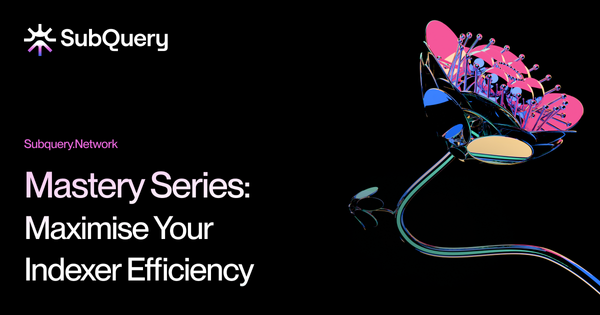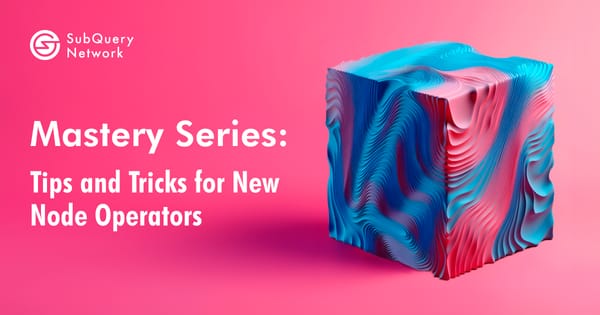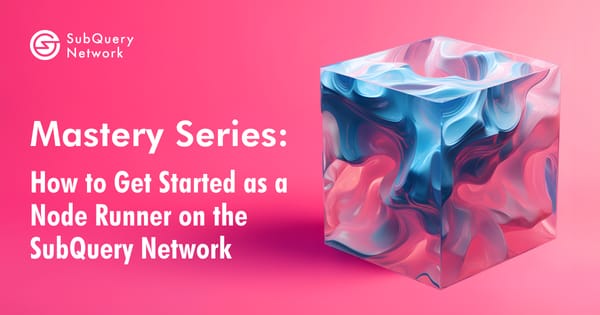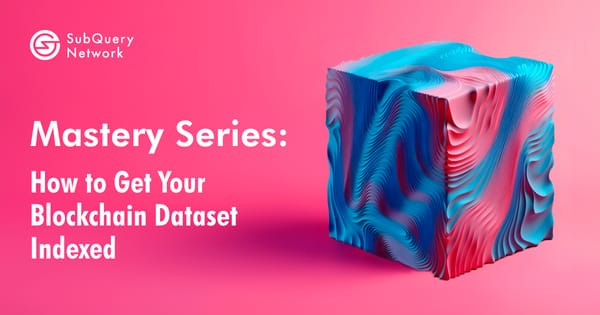Today we’re coming to you with another instalment of the SubQuery Mastery Series, where we help you navigate the SubQuery Network and help you maximise your potential rewards. If you’re reading this article, you’ve probably come across SQT and you’re wondering if it’s legit and how it works.
Here we will delve into the multifaceted aspects of SQT, beginning with its economic framework and extending to an overview of the key infrastructure services that can be obtained with SQT. Additionally, we'll outline the rewards system that incentivises participants as well as governing decisions of the SubQuery Network which are driven by SQT. By the end of this article, you'll have a comprehensive understanding of the power of SQT, and you’ll know where to access it!
Economics of SQT
The SubQuery token utility token is designed to facilitate the transfer of value of blockchain access and indexed data on the SubQuery network. Consumers who require access to RPC services or indexed blockchain data to power their dApps are required to obtain SQT in order to pay for these services. Node Operators then provide this service via the SubQuery Network and are rewarded with SQT.
Node Operators do a lot of work within the SubQuery Network. They decide which RPCs and data indexer projects to run, maintain their infrastructure, and also provide valuable feedback on improvements and new features. Therefore, Node Operators receive more rewards than other participants such as Delegators.
The amount of rewards a Node Operator gets is proportional to the work that it does in serving queries and also proportional to the amount of stake it has allocated for each particular SubQuery project.
Delegators support Node Operators by increasing the amount of stake of a Node Operator. Node Operators then share their rewards with Delegators as a "token" of appreciation. The more delegation an Operator receives, the more potential rewards it can earn, meaning the more it can share back to its Delegators.
One of the key focuses of SubQuery is to increase the amount of queries served to blockchain projects. As more and more blockchain projects solve real world problems, more blockchain data will be required. This increase in demand for blockchain data from the SubQuery network will increase the value that the network provides.
Some useful stats:
- The current circulating supply of SQT is 1.13B (from a maximum of 10B).
- 15% of SQT locked in the network.
- 37 Operators
- 1012 Delegators
See our dashboard for more information.
Accessing Indexed Data or RPCs
The SubQuery Network is a web3 infrastructure marketplace. A place where developers can come to obtain completely decentralised, performant and reliable infrastructure such as indexed datasets and RPCs.
Users looking for indexed blockchain data and RPCs on the SubQuery Network are called Consumers. Consumers are typically dApp (decentralised application) developers, data analytic companies, blockchain networks, middleware developers, or even web aggregating companies that need access to blockchain data or performant RPCs to provide services to their end-users.
Consumers can easily create plans to access RPCs or start querying data from their chosen indexed project via our decentralised network of Node Operators. And how do they pay for these plans? You guessed it, in SQT!
SQT serves as a medium of exchange for transactions for Consumers to obtain Node Operator services. For more on accessing these services, read the previous Mastery Series articles below:
How to Access Decentralised RPCs on the SubQuery Network
How to Get Your Blockchain Dataset Indexed on the SubQuery Network
SQT Rewards
There are two key participants that earn rewards on the SubQuery Network; Node Operators and Delegators. See the next section on ‘Staking’ to learn more about Delegators and how they earn rewards.
Node Operators are rewarded via two sources:
- Reward for productive work: For serving requests for a project via the various payment methods that we have pioneered, e.g. serving requests in valid service agreements or flex plans.
- Network inflation rewards: This is allocated to all Indexers for successfully running projects and serving requests.
These two categories of rewards are then distributed to Node Operators and Delegators based on the Node Operator Commision Rate, and then by the proportional stake of each participant.
In our vision, as the network matures, rewards for productive work will dominate Node Operator rewards. However, we understand that in the early days, we will leverage Network Inflation rewards to help bootstrap the network as applications get deployed and the end user base scales.
You can find your pending and claimed rewards by selecting ‘Rewards’ under the wallet switcher of the SubQuery Network app or go straight here: https://app.subquery.network/profile/rewards
To go deeper into Node Operator rewards, you can visit our documentation.
Staking
Delegating is the term used in the SubQuery Network which is where participants take their SQT tokens and stake them to a specific Node Operator. In exchange, you receive SQT rewards back with an APY that varies but typically hovers around 15%.
This is where the majority of SQT tokens are contributed to the SubQuery Network because anyone can do it!
Delegators play a vital role in securing the network without the need to operate a SubQuery Indexer or RPC node themselves. Because of this, the Delegator role is the perfect fit for less technical folk who want to contribute to the success of SubQuery and support their favourite Node Operators, while also receiving rewards in return.
There is no minimum delegation required to be a Delegator. This means that anyone can join no matter how much SQT they have access to. Start delegating today but following the video and guide here.
Governance
The involvement of SQT in governance is a key aspect of the SubQuery Network token. SQT can serve as a means of voting power in our decision making for the direction of the network. This mechanism incentivises token holders to actively participate in governance and align their interests with the long-term success of the network.
For an in-depth look at the SubQuery Governance process, check out this proposal on initialising SubQuery Governance which was ultimately approved: https://forum.subquery.network/t/smp-1-included-initialising-subquery-governance/539
If you want to make a proposal today to the network you can find out how by following our governance guide here: https://academy.subquery.network/subquery_network/governance/introduction.html
Where to get SQT
You can acquire SQT through any of these centralised exchange:
SQT is on a number of DEX Pools however most liquidity is on Uniswap.
Remember if you buy your SQT on Ethereum you will need to bridge it to Base where the SubQuery Network is built, follow this guide on bridging to Base.
Adding SQT to Your Wallet
SQT is an ERC20 token deployed on the Ethereum mainnet, and is commonly bridged over to Base. It has the following contract addresses:
Ethereum mainnet: 0x09395a2A58DB45db0da254c7EAa5AC469D8bDc85
Base: 0x858c50C3AF1913b0E849aFDB74617388a1a5340d
You can add it to your wallet from the wallet selector in the Network App by selecting “Import SQT to wallet”.
Once you have some SQT in your favourite wallet, head to the SubQuery Network app and get started.
About SubQuery
SubQuery Network is innovating web3 infrastructure with tools that empower builders to decentralise the future. Our fast, flexible, and open data indexer supercharges dApps on over 200 networks, enabling a user-focused web3 world. Soon, our Data Node will provide breakthroughs in the RPC industry, and deliver decentralisation without compromise. We pioneer the web3 revolution for visionaries and forward-thinkers. We’re not just a company — we’re a movement driving an inclusive and decentralised web3 era. Let’s shape the future of web3, together.
Linktree | Website | Discord | Telegram | Twitter | Blog | Medium | LinkedIn | YouTube







